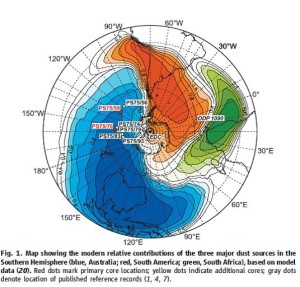By Ignacio A. Jara and Helen Bostock
Terrestrial dust is important to the climate system not only because it may alter the solar radiative balance of the earth, but also because it supplies the oceans with key iron (Fe), a limiting micronutrient for phytoplankton productivity in the Southern Ocean. The “Iron Hypothesis” was first proposed by Martin (1990) [1], who suggested that changes in Fe supplied impact on the biological productivity in the Southern Ocean which, in turn, could influence the glacial-interglacial changes in atmospheric CO2. However over the last 20 years scientists have struggled to find evidence to support this theory.
In the present-day Atlantic Southern Ocean an increase in terrestrial dust influx or volcanic aerosols has been linked to vast biological blooms. An increase in biological activity is associated with a high consumption of nutrients and transfers carbon back to the deep ocean. In 2009 an article published in Nature [2] explored past dust-climate interactions in this part of the Southern Ocean (42°S) by presenting an offshore dust record extending back to 4 million years.
This study of a long Ocean Drilling Program (ODP) core from the South Atlantic provided -with unprecedented detail- evidence for a consistently enhanced terrestrial dust influx during ice ages. It also showed a tight coupling with dust deposition in Antarctic ice cores over the last 0.8 million years, indicating that large areas of the Southern Ocean and Antarctica were affected by the glacial dust plume. According to the authors, the glacial dust was the result of an increased aridity of the eastern Patagonian plains (just upwind from the coring site), which increased the dust availability; as well as stronger and northward shifted Southern Hemisphere Westerly Winds, which enhanced the offshore transport of the Patagonian dust.
Has something similar occurred in larger Pacific sector of the Southern Ocean?
The dust record from a new set of cores collected by the RV Sonne 2010 from the Pacific Southern Ocean has recently been published in Science [3], and shows a similar pattern of variability in dust fluxes for this region over the last 1 million years [3]. The increased glacial dust deposition in the Pacific Southern Ocean is probably the result of enhanced supply from the Australian continent (with potential contributions from New Zealand), as modelling suggests this landmass is the main present-day dust source in the southern Pacific. However, geochemical fingerprinting of the dust will be required to determine the exact source.
Figure: Modern terrestrial dust sources across the Southern Ocean based on modelling data (Lamy et al., 2014)
Interestingly, dust influxes during glaciations prior to 0.5 million years seem to have been significantly lower in the Pacific than in the Atlantic (Figure 2), something that may be explained by a less intense glacial desiccation of Australia due to its relatively northern position compared with Patagonia.
So has the increased dust/Fe translated into increased productivity?
There is evidence for some increase in productivity from opal flux, n-alkanes and barium concentrations in some of the cores north of the Polar Front. But there is a large reduction in productivity south of the Polar Front, resulting in an overall decrease in total biogenic opal production during the glacials in the South Pacific [4], and thus unlikely to draw-down the atmospheric CO2.
Figure: Lithogenic and biogenic proxies from the subantarctic waters of the South Pacific (Lamy et al., 2014)
Modern iron fertilization experiments have also had mixed results; early experiments such as Ironex and SOIREE produced large blooms visible from space [5], while several subsequent experiments have not witnessed any major changes in phytoplankton concentrations. There is also the question of whether the blooms actually result in organic carbon being transferred to the deep ocean.
It is clear that more work is required to understand the link between dust, biological productivity and CO2 ventilation in the Southern Ocean .
References:
- Martin, J.H., 1990. Glacial-interglacial CO2 change: The Iron Hypothesis. Paleoceanography, 5, 1-13.
- Martinez-Garcia, A., et al., 2011. Southern Ocean dust-climate coupling over the past four million years. Nature 476, 312-315.
- Lamy, F., et al., 2014. Increased dust deposition in the Pacific Southern Ocean during glacial periods. Science 343, 403-407.
- Bradtmiller L., et al., 2009. Comparing glacial and Holocene opal fluxes in the Pacific sector of the Southern Ocean. Paleoceanography, 24, PA2214, doi:10.1029/2008PA001693
- Boyd P.W. et al (2007) Iron enrichment experiments 1993-2005: synthesis and future directions. Science 315, 5812, 612-7.

